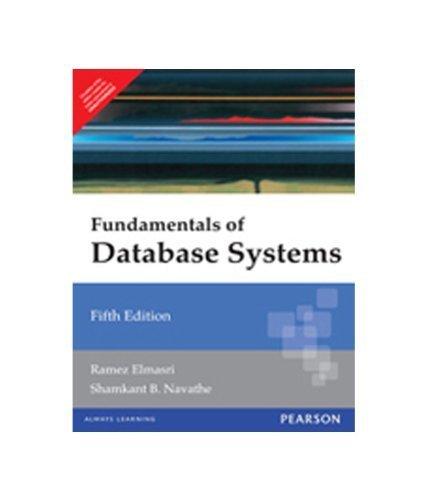Question
8. John is worried about the company using the new system. This would be considered part of: a.Technical feasibility b.Organizational feasibility c.Economic feasibility d.Risk feasibility
8. John is worried about the company using the new system. This would be considered part of:
a.Technical feasibility
b.Organizational feasibility
c.Economic feasibility
d.Risk feasibility
e.Hardware feasibility
9. One of the most important tasks in developing the use case is:
a.Identify all the major steps in the use case
b. Looking up other references
c.Listing the design process
d.Implementing the programs
e.None of the above
10. Root Cause Analysis tries to find _____.
a. How long each process takes in the as-in system with an eye at shortening the time
b. How much each process costs (rather than the time) with an eye at cutting costs
c. The true problem and not just symptoms of problems and solve that
d. Technologies that could work
e. Other companies that have similar processes and attempt to learn from them
11.Which of the following project roles would focus on new business processes and value?
a. Systems analyst
b. Infrastructure analyst
c. Change management analyst
d. Business analyst
e. Project manager
12. One of the problems when doing requirements determination is:
a. Exclusion of business users and failure to address the true business needs of the users
b. Inclusion of data tables
c. Inclusion of business logic
d. Inclusion of a list of processes the system needed to perform
e. Over-reliance on object oriented systems analysis and design
14. Which is generally NOT true about non-functional requirements?
a. Cultural differences can be considered
b. Color interpretations on screens and forms may be different in different geographical places
c. Multi-lingual interfaces many be needed
d. Systems may need to adapt from global solutions to local realities
e. Systems may need to have actual expenses from global operations
15. Peter is doing an economic analysis using todays dollar values. He is doing:
a. Cash flow analysis
b. Return on investment analysis
c. Net present value analysis
d. Break-even point analysis
e. Internal rate of return analysis
Part-II True or False Questions
[15 Questions Each question carry 1 mark]
|
| Question | True/False |
| 1 | CASE stands for Computer Aided Service Engineering. |
|
| 2 | Management of requirements and system scope is one of the hardest parts of managing a project. |
|
| 3 | In RAD or agile development methodology (especially with BPR), a significant amount of time and effort is spent in understanding the as-is system. |
|
| 4 | The primary goal of a system is to create value for the organization. |
|
| 5 | Using industry standards, the general estimated project time for the implementation phase is 15%. |
|
| 6 | In use case, an actor must be a person that interacts with the system. |
|
| 7 | Use case model is an external or functional-view of the business process. |
|
| 8 | Being a systems analyst is one of the most interesting, exciting and challenging jobs available. |
|
| 9 | Use case is only used to describe the current existing system, NOT the proposed system. |
|
| 10 | JAD stands for Joint Application Design. |
|
| 11 | Use case diagram represent actors in the use case as human matchstick figure even if the actor is non-human. |
|
| 12 | Once the list of interviews is determined, it rarely grows. |
|
| 13 | The most commonly used requirements gathering technique is the interview. |
|
| 14 | The project methodology that takes the longest to complete is Throwaway Prototyping Methodology. |
|
| 15 | A temporal trigger means an action that is taken as a result of the actor clicking an input button. |
|
Long Questions
Q.4) We all are familiar with the Bank ATM machine that we use to withdraw money. In this situation, you are required to add the functionality of Deposit Money using the ATM machine. Write a formal Use Case document for the process described below. Describe the success scenario and the alternate scenarios. [7 points]
A deposit transaction is started from within a session when the customer chooses deposit from the menu of possible transaction types. The customer chooses a type of account to deposit to (e.g. checking) from a menu of possible accounts, and then chooses a dollar amount by typing it on the keyboard. The system sends the customer's card number, PIN, chosen account and amount to the bank, which either approves or disapproves the transaction. If the transaction is approved, the machine accepts an envelope from the customer containing cash and/or checks and then issues a receipt. (If the customer does not insert the envelope within a specified period of time, this operation times out and the deposit transaction is aborted). If the transaction is disapproved due to an incorrect PIN, the Incorrect PIN extension is executed. All other disapprovals are reported to the session, which initiates the Failed Transaction Extension. The bank is notified whether or not an approved transaction was completed in its entirety by the machine; if it is completed then the bank completes crediting the customer's account for the amount - contingent on manual verification of the deposit envelope contents by an operator later.
Step by Step Solution
There are 3 Steps involved in it
Step: 1

Get Instant Access to Expert-Tailored Solutions
See step-by-step solutions with expert insights and AI powered tools for academic success
Step: 2

Step: 3

Ace Your Homework with AI
Get the answers you need in no time with our AI-driven, step-by-step assistance
Get Started


